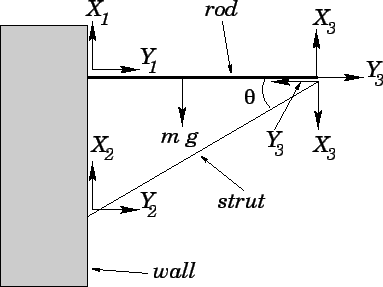Question: A uniform horizontal rod of mass
![]() is
attached to a vertical wall at one end, and is supported, from below, by a
light rigid strut at the other. The strut is attached to the rod at one end,
and the wall at the other, and subtends an angle of
is
attached to a vertical wall at one end, and is supported, from below, by a
light rigid strut at the other. The strut is attached to the rod at one end,
and the wall at the other, and subtends an angle of
![]() with the
rod. Find the horizontal and vertical reactions at the point where the strut is
attached to the rod, and the points where the rod and the strut are attached to
the wall.
with the
rod. Find the horizontal and vertical reactions at the point where the strut is
attached to the rod, and the points where the rod and the strut are attached to
the wall.

Answer: Let us call the vertical reactions at the joints ![]() ,
, ![]() , and
, and ![]() .
Let the corresponding horizontal reactions be
.
Let the corresponding horizontal reactions be ![]() ,
, ![]() , and
, and ![]() . See the diagram.
Here, we have made use of the fact that the strut and the rod exert equal and opposite
reactions on one another, in accordance with Newton's third law.
Setting the net vertical force on the rod to zero yields
. See the diagram.
Here, we have made use of the fact that the strut and the rod exert equal and opposite
reactions on one another, in accordance with Newton's third law.
Setting the net vertical force on the rod to zero yields
Setting the net torque acting on the rod about the point where it
is connected to the wall to zero, we obtain
In summary, the vertical reactions are
![]() , and the horizontal reactions are
, and the horizontal reactions are
![]()